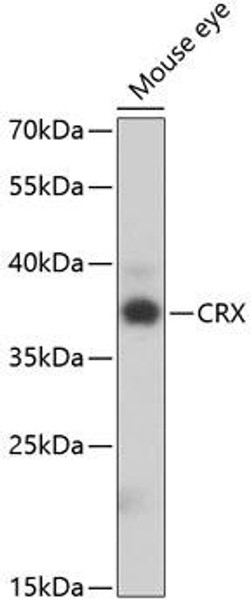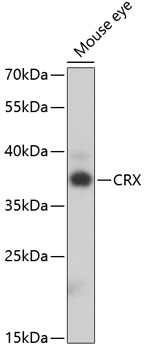Anti-CRX Antibody (CAB5719)
- SKU:
- CAB5719
- Product type:
- Antibody
- Reactivity:
- Mouse
- Rat
- Host Species:
- Rabbit
- Isotype:
- IgG
- Antibody Type:
- Polyclonal Antibody
- Research Area:
- Developmental Biology
Frequently bought together:
Description
| Antibody Name: | Anti-CRX Antibody |
| Antibody SKU: | CAB5719 |
| Antibody Size: | 20uL, 50uL, 100uL |
| Application: | WB |
| Reactivity: | Mouse, Rat |
| Host Species: | Rabbit |
| Immunogen: | Recombinant fusion protein containing a sequence corresponding to amino acids 120-285 of human CRX (NP_000545.1). |
| Application: | WB |
| Recommended Dilution: | WB 1:500 - 1:2000 |
| Reactivity: | Mouse, Rat |
| Positive Samples: | Mouse eye |
| Immunogen: | Recombinant fusion protein containing a sequence corresponding to amino acids 120-285 of human CRX (NP_000545.1). |
| Purification Method: | Affinity purification |
| Storage Buffer: | Store at -20°C. Avoid freeze / thaw cycles. Buffer: PBS with 0.02% sodium azide, 50% glycerol, pH7.3. |
| Isotype: | IgG |
| Sequence: | KAGT SPRP STDV CPDP LGIS DSYS PPLP GPSG SPTT AVAT VSIW SPAS ESPL PEAQ RAGL VASG PSLT SAPY AMTY APAS AFCS SPSA YGSP SSYF SGLD PYLS PMVP QLGG PALS PLSG PSVG PSLA QSPT SLSG QSYG AYSP VDSL EFKD PTGT WKFT YNPM DP |
| Gene ID: | 1406 |
| Uniprot: | O43186 |
| Cellular Location: | Nucleus |
| Calculated MW: | 32kDa |
| Observed MW: | 37kDa |
| Synonyms: | CRX, CORD2, CRD, LCA7, OTX3 |
| Background: | The protein encoded by this gene is a photoreceptor-specific transcription factor which plays a role in the differentiation of photoreceptor cells. This homeodomain protein is necessary for the maintenance of normal cone and rod function. Mutations in this gene are associated with photoreceptor degeneration, Leber congenital amaurosis type III and the autosomal dominant cone-rod dystrophy 2. Several alternatively spliced transcript variants of this gene have been described, but the full-length nature of some variants has not been determined. |
| UniProt Protein Function: | CRX: Binds and transactivates the sequence 5'-TAATC[CA]-3' which is found upstream of several photoreceptor-specific genes, including the opsin genes. Acts synergistically with other transcription factors, e.g. NRL and RX, to regulate photoreceptor cell-specific gene transcription. Essential for the maintenance of mammalian photoreceptors. Defects in CRX are the cause of Leber congenital amaurosis type 7 (LCA7). LCA designates a clinically and genetically heterogeneous group of childhood retinal degenerations, generally inherited in an autosomal recessive manner. Affected infants have little or no retinal photoreceptor function as tested by electroretinography. LCA represents the most common genetic cause of congenital visual impairment in infants and children. Defects in CRX are the cause of cone-rod dystrophy type 2 (CORD2); also known as cone-rod retinal dystrophy 2 (CRD2). CORDs are inherited retinal dystrophies belonging to the group of pigmentary retinopathies. CORDs are characterized by retinal pigment deposits visible on fundus examination, predominantly in the macular region, and initial loss of cone photoreceptors followed by rod degeneration. This leads to decreased visual acuity and sensitivity in the central visual field, followed by loss of peripheral vision. Severe loss of vision occurs earlier than in retinitis pigmentosa. Defects in CRX are a cause of retinitis pigmentosa (RP). RP leads to degeneration of retinal photoreceptor cells. Patients typically have night vision blindness and loss of midperipheral visual field. As their condition progresses, they lose their far peripheral visual field and eventually central vision as well. Belongs to the paired homeobox family. |
| UniProt Protein Details: | Protein type:DNA-binding Chromosomal Location of Human Ortholog: 19q13.3 Cellular Component: transcription factor complex; nucleus Molecular Function:leucine zipper domain binding; protein binding; chromatin binding; transcription factor activity; nuclear hormone receptor binding Biological Process: circadian rhythm; organ morphogenesis; regulation of transcription, DNA-dependent; visual perception; transcription, DNA-dependent; positive regulation of photoreceptor cell differentiation; retina development in camera-type eye; response to stimulus; positive regulation of transcription from RNA polymerase II promoter Disease: Cone-rod Dystrophy 2; Leber Congenital Amaurosis 7; Retinitis Pigmentosa |
| NCBI Summary: | The protein encoded by this gene is a photoreceptor-specific transcription factor which plays a role in the differentiation of photoreceptor cells. This homeodomain protein is necessary for the maintenance of normal cone and rod function. Mutations in this gene are associated with photoreceptor degeneration, Leber congenital amaurosis type III and the autosomal dominant cone-rod dystrophy 2. Several alternatively spliced transcript variants of this gene have been described, but the full-length nature of some variants has not been determined. [provided by RefSeq, Jul 2008] |
| UniProt Code: | O43186 |
| NCBI GenInfo Identifier: | 3287764 |
| NCBI Gene ID: | 1406 |
| NCBI Accession: | O43186.1 |
| UniProt Secondary Accession: | O43186,Q0QD45, |
| UniProt Related Accession: | O43186 |
| Molecular Weight: | 299 |
| NCBI Full Name: | Cone-rod homeobox protein |
| NCBI Synonym Full Names: | cone-rod homeobox |
| NCBI Official Symbol: | CRX |
| NCBI Official Synonym Symbols: | CRD; LCA7; OTX3; CORD2 |
| NCBI Protein Information: | cone-rod homeobox protein; orthodenticle homeobox 3 |
| UniProt Protein Name: | Cone-rod homeobox protein |
| Protein Family: | Cone-rod homeobox protein |
| UniProt Gene Name: | CRX |
| UniProt Entry Name: | CRX_HUMAN |




